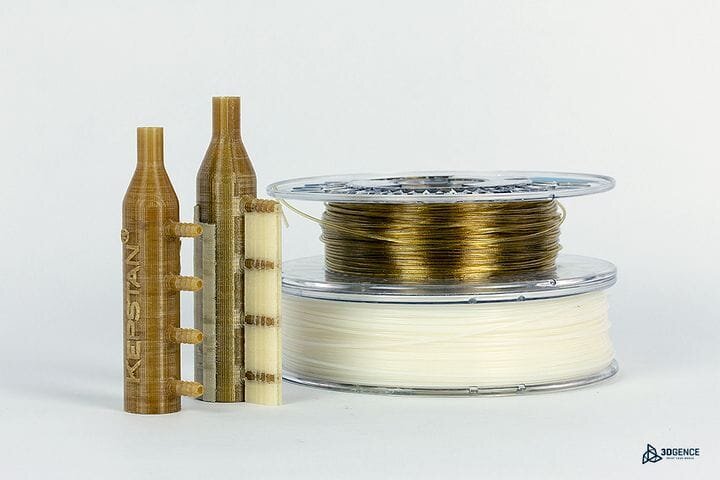![PEKK 3D prints using ESM-10 soluble support material [Source: 3DGENCE]](https://fabbaloo.com/wp-content/uploads/2020/05/image-asset_img_5eb08e3830c0a.jpg)
This could be a first: 3D printing high-temperature PEKK with soluble support.
Poland-based 3DGENCE announced their high-temperature 3D printer, the F340, is now certified to 3D print Kimya’s PEKK-A from Armor Group with a soluble support material, ESM-10.
This is a major step forward for those wishing to 3D print in PEKK because the soluble support material permits easy 3D printing of highly complex geometries. In some complex 3D models, non-soluble supports might be trapped inside and cannot be removed, invalidating the print.
3D Print Support Removal Issues
But soluble support materials are far more powerful. While they hold up overhangs just as well as non-soluble support materials, the difference is in the post-processing. Soluble materials need only be soaked in a solvent, sometimes plain water, and they disappear. There is no possibility of support materials being permanently trapped inside a print.
Even in cases where the non-soluble support material can be removed, it is sometimes attached to delicate portions of the 3D model. It’s then possible to break these delicate segments when pulling off the non-soluble support structures. Again, there is no possibility of this happening with soluble support.
This means that complex 3D models can be 3D printed with almost no concern regarding the model’s complexity or fragility.
That has been a very powerful paradigm for lower-temperature 3D printers, which have used soluble support materials such as PVA for some time. However, the quest for soluble support for high-temperature materials has been a bit more tricky.
This is because the standard soluble support materials used in low-temperature 3D printers won’t work in high-temperature 3D printers. The reason is that in order to 3D print high-temperature materials, the ambient temperature within the build chamber must be quite high.
3DGENCE F340 ESM-10
In the case of 3DGENCE’s F340 device, it has nozzle temperatures of up to 500C, bed temperatures of up to 160C and chamber temperatures of up too 85C. That’s pretty hot!
But when you consider that PVA’s glass transition temperature is only 80C, you will realize that it can’t really support much in such a 3D printing scenario. It would droop badly.
That’s why 3DGENCE created a new, higher-temperature support material, ESM-10.
This unusual support material can easily withstand temperatures of 80C or more, and yet remains soluble. 3DGENCE says it can be “automatically dissolved in dedicated cleaning stations.” They also explain this:
“Due to the possibility of printing at high temperatures, the use of this material does not cause clogging of the hotends. ESM-10 does not recrystallize, which may cause dissolution of the material or failure of the hotends.”
It seems that if you intend on 3D printing PEKK objects that are of high geometric complexity, you’d better consider the 3DGENCE F340 high-temperature 3D printer.
Via 3DGENCE

